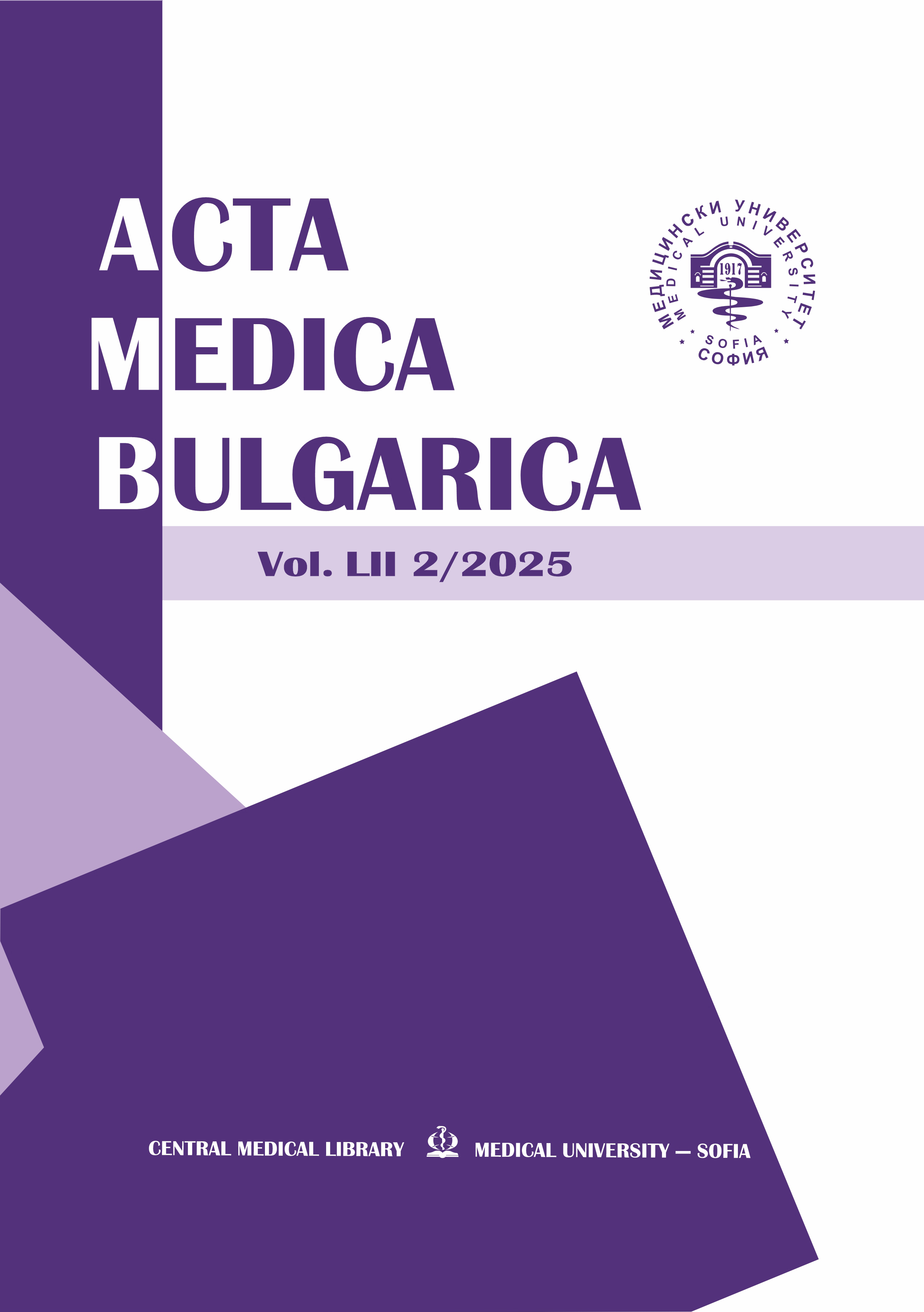Complications after percutaneous biliary drainage placement: a personal experience and a literature review
DOI:
https://doi.org/10.2478/AMB-2025-0042Keywords:
percutaneous transhepatic biliary drainage, PTBD, biliary obstruction, biliary complications, biliary drainage managementAbstract
Background: Percutaneous transhepatic biliary drainage (PTBD) is an essential procedure for managing biliary obstructions, particularly in cases where endoscopic retrograde cholangiopancreatography (ERCP) is unsuccessful or contraindicated. While PTBD is effective, it is associated with a range of complications, necessitating continuous evaluation of its safety and efficacy. Objective: This study aims to provide a comprehensive analysis of the complications and outcomes associated with PTBD during a single specialist’s learning curve. Additionally, a thorough review of the literature on PTBD complications will be conducted, and best practices for preventing and managing complications will be explored, focusing on improving clinical outcomes. Materials and methods: A retrospective analysis of 45 patients who underwent PTBD between 2022 and 2024 was conducted. All procedures were performed under combined ultrasound and fluoroscopy guidance. Data on procedural success, complications, and in-hospital mortality were collected. Complications were classified as minor or major based on clinical significance. The analysis focused on the types of early complications and mortality occurring during the patient’s hospital stay directly related to the procedure. Results: Technical success was achieved in 43 patients (95.5%). Complications were observed in 18 patients (41.9%), with 8 cases (18.6%) classified as major. The most common complication was hemobilia (30.2%), followed by cholangitis, which occurred in 5 patients (11.6%) during their hospital stay. Minor complications were managed conservatively, while major complications required invasive interventions such as embolization for severe hemobilia and percutaneous drainage for abscesses and bilomas. Two patients (4.6%) died during hospitalization due to underlying conditions unrelated to the procedure. Discussion: The findings align with existing literature, emphasizing PTBD’s effectiveness despite a high overall complication rate. Preventive strategies, including adequate pre-procedural preparation and precise catheter placement, are crucial for minimizing risks. This study underscores the importance of early recognition and prompt management of complications, particularly cholangitis and bleeding. Conclusion: PTBD is a safe and effective intervention for biliary obstructions when performed with meticulous technique and appropriate patient selection. Despite its inherent risks, most complications can be effectively managed, reinforcing PTBD’s role in complex biliary cases. Further studies are needed to optimize strategies for reducing complications and improving clinical outcomes.
References
Nennstiel S, et al. Comparison of ultrasound and fluoroscopically guided percutaneous transhepatic biliary drainage. Dig Dis. 2018;36(2):153-160.
Turan AS, et al. Complications of percutaneous transhepatic cholangiography and biliary drainage. Abdom Radiol. 2022;47(8):3338-3344.
Molina H, et al. Complications of percutaneous biliary procedures. Semin Intervent Radiol. 2021;38(4):364-372.
Giurazza F, et al. Safety and eff ectiveness of ultrasound-guided percutaneous transhepatic biliary drainage: a multicenter experience. J Ultrasound. 2019;22(3):321-329.
Kokas B, et al. Percutaneous transhepatic drainage is safe and eff ective in biliary obstruction. PLoS One. 2021;16(11):e0260223.
Houghton EJ, et al. Prospective comparison of bleeding complications between right and left approaches in percutaneous biliary drainage. Surg Laparosc Endosc Percutan Tech. 2019;29(1):7-12.
Lee J, et al. Outcomes and complications of percutaneous biliary drainage: a retrospective study. Radiology. 2020;296(2):320-327.
Robson K, et al. A comprehensive review of PTBD complications and treatment strategies. BMC Gastroenterol. 2018;18(1):95-105.
Johnson T, et al. Clinical guidelines for percutaneous biliary drainage: A review. Hepatobiliary Surg Nutr. 2021;10(3):376-386.
Muller D, et al. Advancements in biliary drainage techniques. J Hepatol. 2017;66(3):644-656.
Patel P, et al. Incidence and management of PTBD complications. World J Gastrointest Surg. 2021;13(9):869-882.
Singh R, et al. Clinical outcomes of PTBD-related complications. J Clin Interv Radiol. 2020;4(1):15-22.
White J, et al. Organ injury in PTBD procedures. J Vasc Interv Radiol. 2019;30(5):781-789.
Chen X, et al. Bleeding risks in percutaneous biliary interventions. Hepatogastroenterology. 2018;65(133):142-148.
Fernandez A, et al. Management of post-PTBD bleeding. J Surg Res. 2021;267:346-354.
Gupta R, et al. Risk factors for bleeding in biliary drainage. Clin Radiol. 2019;74(4):312-318.
Park C, et al. Percutaneous biliary drainage: comparison of right and left approaches. Ann Hepatol. 2020;19(3):287-293.
Morales P, et al. Outcomes of PTBD and bleeding risks. Eur J Radiol. 2018;103:89-94.
Zhao J, et al. Preventive strategies for PTBD complications. Clin Imaging. 2022;82:118-126.
Tan H, et al. Pre-procedural assessment and its impact on PTBD outcomes. Br J Radiol. 2021;94(1122):20201050.
Smith B, et al. Infectious complications post-PTBD. J Gastroenterol Hepatol. 2020;35(7):1129-1137.
Lin D, et al. Bacterial colonization and infection in biliary drainage. Int J Antimicrob Agents. 2019;54(4):497-502.
Kumar S, et al. Prevention and management of catheter-related infections in PTBD. Clin Infect Dis. 2017;65(6):972-980.
Evans M, et al. Best practices for managing PTBD infections. Dig Dis Sci. 2018;63(5):1354-1361.
Chang W, et al. Complications of biliary drainage and management. World J Gastroenterol. 2018;24(3):251-261.
Hernandez C, et al. Treatment strategies for PTBD complications. Ann Surg. 2021;274(3):e245-e250.
Clark A, et al. Efficacy of antibiotic prophylaxis in PTBD. J Hepatobiliary Pancreat Sci. 2020;27(4):253-260.
Lee Y, et al. Bile duct drainage and catheter complications. Radiology. 2018;286(1):270-279.
Anderson K, et al. Infections and prevention strategies in biliary interventions. Am J Gastroenterol. 2021;116(8):1598-1607.
Taylor J, et al. The role of PTBD in advanced biliary obstruction. Clin Liver Dis. 2017;21(3):505-523.
Martin R, et al. Securing PTBD catheters to minimize complications. J Vasc Interv Radiol. 2018;29(12):1677-1683.
Silva A, et al. Catheter maintenance and patient education. Gastrointest Interv. 2020;9(4):287-295.
Ng J, et al. Preventing PTBD catheter dislodgement. J Interv Gastroenterol. 2019;9(1):45-50.
Brown E, et al. PTBD: Improving patient outcomes through education. Ann Hepatol. 2017;16(5):729-738.
Jones H, et al. PTBD complications and prevention. Hepatobiliary Pancreat Dis Int. 2020;19(4):332-341.
Ross P, et al. Bile leakage in biliary interventions. Radiol Clin North Am. 2019;57(2):369-382.
Alexander W, et al. Bile leakage management strategies. Surg Endosc. 2018;32(7):3214-3220.
Downloads
Published
Issue
Section
License
Copyright (c) 2025 Y. Asenov (Author)

This work is licensed under a Creative Commons Attribution-NonCommercial-NoDerivatives 4.0 International License.
You are free to share, copy and redistribute the material in any medium or format under these terms.


 Journal Acta Medica Bulgarica
Journal Acta Medica Bulgarica 